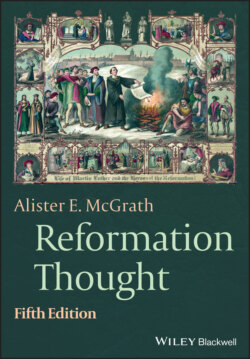Читать книгу Reformation Thought - Alister E. McGrath - Страница 19
The Growth of Anti-Clericalism
ОглавлениеPerhaps unsurprisingly, anti-clericalism became a significant phenomenon in the late Middle Ages, reflecting a number of social concerns about the elevated social status and unimpressive intellectual caliber of the clergy. The tax breaks enjoyed by clergy were the source of particular irritation, especially in times of economic difficulty. In the French diocese of Meaux, there was considerable local resentment because the clergy were exempted from all forms of taxation. In the diocese of Rouen, there was popular outcry over the windfall profits made by the church by selling grain during a period of severe shortage. Irritated by the low intellectual stature of many parish clergy in the early sixteenth century, an increasingly educated Christian laity turned to writers such as Erasmus of Rotterdam (Figure 1.1) to find an intelligent articulation of their faith.
Figure 1.1 Erasmus of Rotterdam in the print shop of his friend Johannes Froben of Basle. Corbis PL279.
Yet despite such valid concerns, the extent and significance of anti-clericalism should not be exaggerated. While there were undoubtedly areas in which such hostility was particularly pronounced – particularly in cities – the clergy were often valued and esteemed, especially in rural areas. Many of the great monasteries of western Europe were respected on account of their social outreach and their significant contributions to the local economy. Yet when all this is taken into account, a rumbling discontent remained, often expressed in what is known as “protest literature” (also known as “grievance literature” or “complaint literature”). Nor should the importance of anti-clericalism for the emergence of the Protestant Reformation be overstated. The Reformation may have reduced the number of clergy through a process of decentralization and the reallocation of some roles traditionally associated with clergy to the laity. Nevertheless, Protestantism retained clergy, even if it may have redefined their responsibilities, and recalibrated their relationship to the laity.
The growth of an educated and literate laity – one of the more significant aspects of the cultural history of Renaissance Europe – led to the publication of an increasing number of criticisms of the church on account of the obvious disparity between what the church was and what it might be or what it was meant to be. The growing level of criticism may well reflect the fact that more people were, through increasing educational opportunities, in a position to criticize the church – rather than any further decline in the ecclesiastical standards of the day. It is true that many religious works of the fifteenth century – often known as a “protest literature” (but sometimes as a “grievance literature” or a “complaint literature”) – paint a picture of growing irritation and protest concerning ecclesiastical corruption and inefficiency. Yet, this might point to levels of expectation of change within the late medieval church as much as declining levels of performance.
However, the reforming movements of this age were not driven purely by a negative discontent. Many reforming movements of the late fifteenth and early sixteenth century took positive inspiration from the institutional simplicity and spiritual integrity of apostolic Christianity. Could not this Golden Age of the Christian faith be regained, perhaps by trying to recapture the simple vision of the church found in the New Testament? Such a program of institutional and moral reform seems to have been the wistful pipe dream of intellectuals throughout half of Europe.
